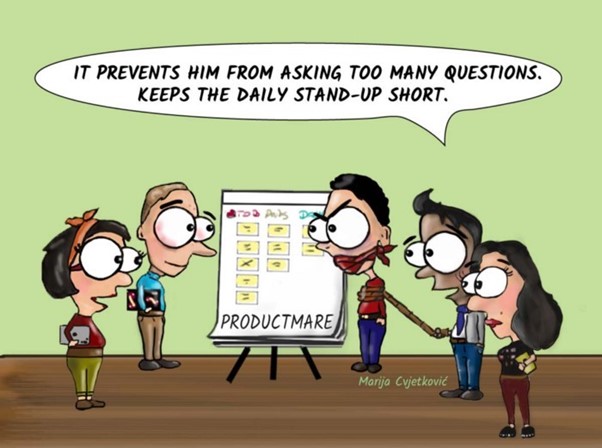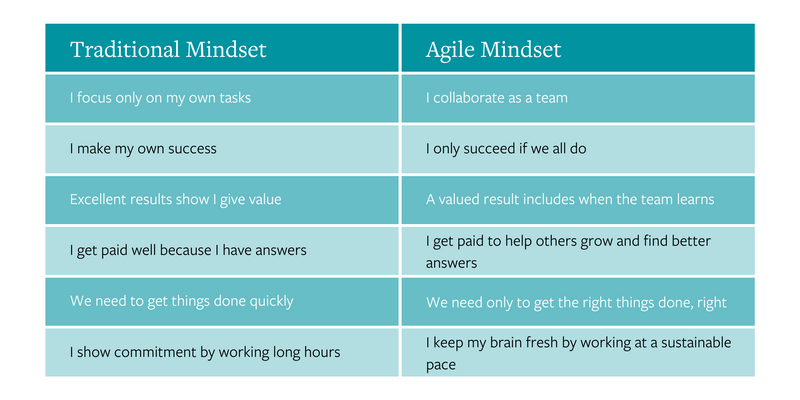What is an Agile Mindset?
Discussions abound on whether Agile is a mindset or a method, and agilists generally agree that applying the process, or method, of agile isn’t enough. We can restructure our teams, divide our work into timeboxed sprints, and add a cadence of team meetings, but if we don’t change the way we think then overall success tends to elude us.

Following the process of an agile workflow can be quite straightforward, but changing the way individuals and organisations think and respond?? Now, that’s a much bigger challenge!
Moving from ‘I’ to ‘We’
From when we first set out on our career journey, we’re taught we need to excel as individuals. We have individual goals, we’re encouraged to make an individual impact, we’re trained that we need to know ‘the answers’ (as individuals), and we need to look no further than ourselves for the seeds of our progression. All of that is partly true. But only partly!
One of the biggest challenges for any team embracing agile ways of working is to start thinking and working as a team. To move from the ‘I’ to the ‘we’, and acknowledge that none of us has the absolute answer in today’s complex world, but just maybe, if we pool our thinking, look at challenges from different perspectives, and collaborate to find a new approach, then maybe we will find a hypothesis to test that can take us forward. You noticed the avoidance of the word ‘answer’? Would you be unsettled if there was no answer? If there were only hypotheses, or new ideas, to experiment with?
Embracing a Growth Mindset
To be truly agile, we need to develop a growth mindset. For ourselves as individuals, for our teams, and for our organisations.
What is a growth mindset, and how does that differ from a traditional mindset?
The term ‘growth mindset’ comes from the work of Dr Carol Dweck and her book ‘Mindset’. If you haven’t read it, maybe add it to your 2023 reading list! Carol Dweck highlights that being successful is not about innate skills and abilities, but about how we approach challenges, and our preparedness to grow and develop. She emphasises that modern society often implies that our talents and potential are in some way fixed at birth. We hear that someone is ‘not good at maths’. What if we simply observed they aren’t good at maths ‘yet’?
She stresses that Thomas Edison didn’t create the lightbulb as 'a single moment of invention’ but that this outcome was the end of a long journey of development, with corporate funding, thirty assistants and a state-of-the-art laboratory. Likewise, for James Dyson, his effort and commitment to learning were massive before his success in inventing a bagless vacuum cleaner. He first started building vacuums in 1979, and it took 15 years and over 5000 attempts to perfect the design. Dweck points out we often underestimate the effort needed to learn and develop. She says:
‘Mindset change is not about picking up a few pointers here and there. It's about seeing things in a new way. When people change to a growth mindset, they change from a judge-and-be-judged framework to a learn-and-help-learn framework.’
Feeding innovation through Psychological Safety
Dyson had the backup of this wife, who we’re told was prepared to be short of money to give him the space to experiment and innovate. Experimentation doesn’t bring guaranteed returns, and so in an organisational setting, people need explicit permission to try new things, to invest time and effort in development, and to continue learning.
Psychological safety is a critical element of an agile mindset. It supports transparency and authenticity, allowing problems to be acknowledged and tackled rather than buried. The concept of a watermelon project is a useful analogy here! How many project dashboards have you seen that have been manipulated to appear green to stakeholders – and yet, when you cut in, they’re red.
An agile way of working needs an agile mindset that allows for transparency to call out problems, that acknowledges ‘the answer’ may require effort and learning to emerge, and that the journey towards the desired outcome may be uncomfortable.
We need to have space and psychological safety to develop and grow. We need to know we won’t be criticised if we don’t succeed, and we need to be supported to continue learning.
Continuing to Learn
In Carol Dweck’s book, there’s a reference to a fixed mindset as being ‘boxed in, in a stand-still world’. Our world is anything but ‘stand-still’! It’s a VUCA world, that seems increasingly volatile, uncertain, complex and ambiguous. For organisations to survive in such a world, they need to become ‘learning organisations’ that sense and explore all around them to understand the shifting context in which they operate, so they can respond and adapt to maintain their value and relevance.
A learning organisation invests in the development of its people, so they can grow and allow the organisation to continually evolve and transform. This is an agile mindset, where we’re targeting growth, where learning is never ‘done’, and where transformation is never complete. A fundamental principle of being agile is to expect change, and where there is change, there is also a need for more learning – and so the cycle continues.
This provides an uncomfortable environment for professionals who have built their careers through their confidence in having ‘the right answers’. What if there is no longer a right answer? What if traditional ‘command and control’ leadership now needs to be replaced by something closer to the role of a gardener, who prepares the ground for other things to grow? In a learning organisation, leaders support others to build their expertise and their thinking. An agile mindset has a big impact on leadership style, and you can read more about that in the Nine Principles of Agile Leadership and the nine short white papers that describe them.
Is Agile a Method or a Mindset?
Exploring the nature of an agile mindset makes it clear that whilst we often know what we need to do to adapt to agile ways of working – e.g. limiting work in progress, focusing on fewer tasks concurrently to release value faster, creating cross-functional teams, and so on – the greater challenge lies in shifting the way we think towards having an agile mindset. The traditional mindset is often heavily ingrained within our organisations. Training will give us information on how an agile way of working is intended to operate, but it takes time, coaching, and commitment throughout all levels of an organisation to loosen deeply entrenched beliefs to make space for new possibilities and true innovation. For me, this is the essence of an agile mindset.

Looking for a place to start your mindset shift?
Try the OU microcredential in Agile Leadership & Management
Please note blogs reflect the opinions of their authors and do not necessarily reflect the recommendations or guidance of the Agile Business Consortium.
